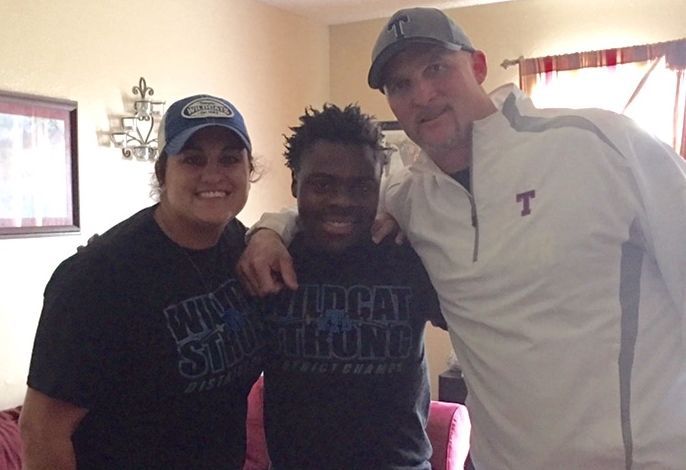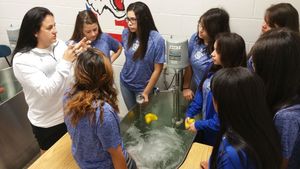
The last thing that Temple High School sophomore De’Aveun Banks remembers about the day he collapsed was attending track practice on March 30 at Wildcat Stadium.
No warning. No preexisting condition. No way this would be the end for the 16-year-old student-athlete who lay motionless on the ground with a faint pulse.
De’Aveun’s mother, Shanee Banks, and Windee Skrabanek, an athletic trainer for the Temple Independent School District who administered CPR to De’Aveun in those crucial moments before the ambulance arrived, talked about the near-tragedy publicly for the first time Monday.
Skrabanek said it was like an ordinary day at work, until a couple of her athletic training students ran into the training room yelling for her.
“You feel that sense of urgency and you start running and kids are screaming your name,” she said. “And when I got there — he was on the ground.”
An overwhelmed Skrabanek broke down into tears recalling that specific moment. The mood in the room was heavy as De’Aveun rolled over to her in his chair placing his arm around her shoulders — comforting the athletic trainer who saved his life.
“I started just rubbing on his chest saying, ‘De’, De’, De’ — can you hear me? Hey! Talk to me! Talk to me!’” Skrabanek said.
When he didn’t respond all 15 years of Skrabanek’s experience as an athletic trainer took over.
“That is when you go into the emergency action plan,” Skrabanek said.
What Skrabanek describes may have seemed like organized chaos, with coaches calling 911, her shouting protocol commands and students standing back in disbelief.
Skrabanek said they immediately brought out the automated external defibrillator, a portable device that can diagnose life-threatening cardiac arrhythmias and can deliver electrical therapy as needed.
As they waited for the ambulance, during that 5-minute window, Skrabanek worked on De’Aveun.
“At this time we are checking for a pulse,” she said. “It was at that time we stuck the pads on and the AED (defibrillator) takes over from there — so then that becomes your coach.”
The defibrillator, which uses verbal and visual commands while keeping track of time and each action taken, initially surveys the condition of the heart.
“Those 10 seconds of analyzing seemed like 15 minutes,” she said. “But then it did a shock right away and then says, ‘Check airway. Check breathing. Check circulation. Start CPR’— and then I started CPR right away.”
She went back and forth with CPR as the defibrillator sent shocks to De’Aveun’s chest.
“The fact that he was already getting five minutes of care prior to them getting there … it was a miracle that he was where he was and we had personnel there with the right equipment,” she said.
De’Aveun was transported to McLane Children’s Scott & White Hospital. After being in critical but stable condition, he was airlifted to Texas Children’s Hospital in Houston where he received specialized pediatric heart care in the intensive care unit for 2½ weeks.
“No history, no health issues. He has always been — just healthy,” Shanee said.
Skrabanek said doctors, who are still running tests, are leaning towards a condition called myocarditis. It is the inflammation of the heart that often has no symptoms and can occur as a result of an infection.
De’Aveun returned to school April 18, less than three weeks after his collapse. He now wears a LifeVest under his shirt. It is a wearable defibrillator that monitors his heart and provides feedback to doctors in Houston.
“They are reading it 24 hours, but mostly while he sleeps,” Shanee Banks said.
He meets regularly with his doctors in Temple to monitor his progress.
De’Aveun hopes to return to a winning Wildcat football team as a linebacker — as of right now he is not allowed do any physical activity.
“He works with his position’s group in the mental aspect,” Skrabanek said. “He motivates and helps coach them up.”
His mother said she is supportive of his return to sports.
“That is his passion. It is what he loves and has been all he has known since he was 6,” Shanee said.
As for De’Aveun, the second oldest of three siblings, he said he is not worried about the future.
“I am feeling great,” De’Aveun said.
“He is back to the same old, bubbly, smiling kid that is full of energy,” Shanee said. “It is a blessing! I am overjoyed, but overly protective now.”
De’Aveun said he is grateful for Skrabanek and her efforts.
“I am glad she was there, at the right time — to bring me back,” De’Aveun said.
“This is the best reward right here,” the trainer said, tapping De’Aveun on the knee. “Seeing him throughout was amazing. It wasn’t just me, it was everyone who worked together to follow the actions that needed to take place.”
Shanee said she not only appreciates his classmates and school who were excited for his return, but the entire community rallying behind her son.
“The community, people near and far,” Shanee said. “…We are blessed. He is blessed. We are just grateful that he is here with us.”
CLICK HERE FOR ORIGINAL ARTICLE


